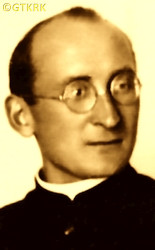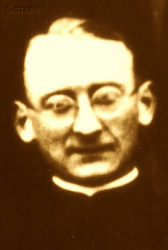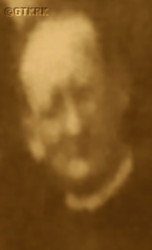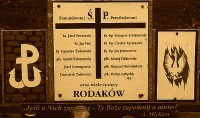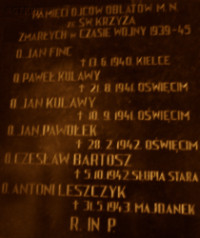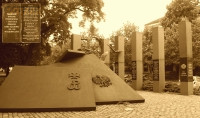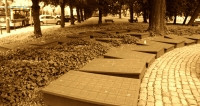Roman Catholic
St Sigismund parish
05-507 Słomczyn
85 Wiślana Str.
Konstancin deanery
Warsaw archdiocese, Poland
full list:
displayClick to display full list

searchClick to search full list by categories
wyświetlKliknij by wyświetlić pełną listę po polsku

szukajKliknij by przeszukać listę wg kategorii po polsku

Martyrology of the clergy — Poland
XX century (1914 – 1989)
personal data
religious status
Servant of God
surname
FINC
forename(s)
John (pl. Jan)
function
religious cleric
creed
Latin (Roman Catholic) Church RCmore on
en.wikipedia.org
[access: 2014.09.21]
congregation
Congregation of Missionary Oblates of Mary Immaculate OMImore on
en.wikipedia.org
[access: 2013.05.19]
(i.e. Oblates)
diocese / province
Polish province OMI
Katowice diocesemore on
en.wikipedia.org
[access: 2013.05.19]
date and place
of death
28.06.1940

Kielcetoday: Kielce city pov., Holy Cross voiv., Poland
more on
en.wikipedia.org
[access: 2021.06.07]
alt. dates and places
of death
12.06.1940, 13.06.1940
details of death
After German invasion of Poland on 01.09.1939 (Russians invaded Poland 17 days later) and start of World War II, after start of German occupation, arrested by the Germans on 03.04.1940, together with 3 other friars.
Accused of having contact with Polish clandestine resistance — German political police Gestapo agents arresting him apparently found a caricature of national socialist leader, Adolf Hitler, in the pocket of his cassock.
The monastery chronicle contains the following entry: „Father Finc was beaten three times, when he fainted, they revived him and told him in front of the altar that this was only the first fall of Christ, and He had three […] When Father Superior was brought to the church beaten and bleeding, they ordered him to kneel before the altar of St Joseph, and one of the Gestapo men took the cross from the altar and placed it in front of Father Superior, ordering him to kiss it. When Father Superior wanted to put his mouth close to it, the Gestapo man hit him in the face with it. Blood poured from his mouth and he fainted”.
Held in Kielce prison — initially in a cramped cell in the basement, then in the political ward.
Sentenced by the Germans — prob. by the kangaroo, genocidal German Standgericht der Sicherheitspolizei (Eng. summary court of the security police) — to death.
Murdered in an execution of 63 Poles in a forest by the Forest Stadium in Kielce.
cause of death
mass murder
perpetrators
Germans
sites and events
KielceClick to display the description, GeneralgouvernementClick to display the description, «Intelligenzaktion»Click to display the description, Ribbentrop‐MolotovClick to display the description, Pius XI's encyclicalsClick to display the description
date and place
of birth
06.09.1910

Siemońtoday: Zławieś Wielka gm., Toruń pov., Kuyavia‐Pomerania voiv., Poland
more on
en.wikipedia.org
[access: 2021.12.18]
religious vows
15.08.1928 (temporary)
12.09.1931 (permanent)
presbyter (holy orders)
ordination
08.04.1934

positions held
1939 – 1940
superior — Słupia Nowatoday: Nowa Słupia, Nowa Słupia gm., Kielce pov., Holy Cross voiv., Poland
more on
en.wikipedia.org
[access: 2021.09.29] ⋄ Congregation's house (Holy Cross, on Łysa Góra (Eng. Bald Mountain)), Oblates OMI
1934 – 1939
friar and teacher — Lubliniectoday: Lubliniec urban gm., Lubliniec pov., Silesia voiv., Poland
more on
en.wikipedia.org
[access: 2021.04.02] ⋄ Minor Theological Seminary i.e. Juniorate (equiv. to gymnasium), St Stanislav Kostka the Confessor Congregation's house, Oblates OMI — lecturer of Polish literature
till 1934
student — Obratoday: Wolsztyn gm., Wolsztyn pov., Greater Poland voiv., Poland
more on
en.wikipedia.org
[access: 2021.12.18] ⋄ Higher Theological Seminary i.e. Scholasticate, St Bernard Congregation's house, Oblates OMI
1927 – 1928
novitiate — Markowicetoday: Strzelno gm., Mogilno pov., Kuyavia‐Pomerania voiv., Poland
more on
en.wikipedia.org
[access: 2021.06.07] ⋄ Immaculate Conception of the Blessed Virgin Mary Congregation's house, Oblates OMI
from 1922
pupil — Lubliniectoday: Lubliniec urban gm., Lubliniec pov., Silesia voiv., Poland
more on
en.wikipedia.org
[access: 2021.04.02] ⋄ Minor Theological Seminary i.e. Juniorate (equiv. to gymnasium), St Stanislav Kostka the Confessor Congregation's house, Oblates OMI
others related
in death
BARTOSZClick to display biography Ceslav, KULAWYClick to display biography John William, KULAWYClick to display biography Paul, LESZCZYKClick to display biography Anthony, PAWOŁEKClick to display biography John
sites and events
descriptions
Kielce: The prison at Zamkowa Str. in Kielce was opened in 1826‐1828. In 09.1939, after start of German occupation, under German control. Initially a POW camp and next prison run by German political police Gestapo. Till 1945 more then c. 16,000 prisoners were held there. Any time c. 2,000 were incarcerated, in space build for c. 400 people. Prisoners, in extremely cramped conditions, were starved, ill‐treated and murdered in prison, executed outside, transported to German concentration camps or deported to slave labour sites. Prison chapel Germans used as torture chamber. At the same time in 08.1941 (after German attack on 22.06.1941 of their erstwhile ally, Russians, do till the autumn of 1944 in Fijałkowski’s barracks in Kielce Bukówka district Germans set up a POW camp for Russian prisoners (branch of Stalag XII C „Kamienna” in Skarżysko‐Kamienna, later of Stalag 367 Częstochowa). According to one of the witnesses first 100 POWs were brought in 09.1941. A week later 4,500 more arrived and within a fortnight another 5,000. Following that the POWs were brought in groups of 500‐1,000. Altogether c. 15,000‐20,000 Russian POWs were held in the camp. POWs slaved at forest clearances, digging sewage ditches, at train loading. They got a hunger rations (as a result acts of cannibalism took place). Slept in unheated barracks. Were beaten and tortured (with wooden battons). Received to medical help. For any type of transgression they were penalized with execution. The camp was managed by the Germans and was supported by a camp’s militia, composed mainly by the Ukrainians. Only few hundred prisoners survived who in the autumn of 1944 were transferred to other camps. From 1945 in Russian Commie‐Nazi hands. Till 1956 many political prisoners, e.g. members of former restistance Home Army AK and National Armed Forces NSZ (part of Polish Clandestine State) where held camptive there. On 04‐05.1945 Polish partisans commanded by Mjr Anthony Heda attacked the prison and release c. 700 prisoners. (more on: www.chroniclesofterror.plClick to attempt to display webpage
[access: 2020.02.08])
Generalgouvernement: After the Polish defeat in the 09.1939 campaign, which was the result of the Ribbentrop‐Molotov Pact and constituted the first stage of World War II, and the beginning of German occupation in part of Poland (in the other, eastern part of Poland, the Russian occupation began), the Germans divided the occupied Polish territory into five main regions. In two of them new German provinces were created, two other were incorporated into other provinces. However, the fifth part was treated separately, and in a political sense it was supposed to recreate the German idea from 1915 (during World War I, after the defeat of the Russians in the Battle of Gorlice in 05.1915) of creating a Polish enclave within Germany. Illegal in the sense of international law, i.e. Hague Convention, and public law, managed by the Germans according to separate laws — especially established for the Polish Germ. Untermenschen (Eng. subhumans) — till the Russian offensive in 1945 it constituted part of the Germ. Großdeutschland (Eng. Greater Germany). Till 31.07.1940 formally called Germ. Generalgouvernement für die besetzten polnischen Gebiete (Eng. General Government for the occupied Polish lands) — later simply Germ. Generalgouvernement (Eng. General Governorate), as in the years 1915‐1918. From 07.1941, i.e. after the German attack on 22.06.1941 against the erstwhile ally, the Russians, it also included the Galicia district, i.e. the Polish pre‐war south‐eastern voivodeships. A special criminal law was enacted and applied to Poles and Jews, allowing for the arbitrary administration of the death penalty regardless of the age of the „perpetrator”, and sanctioning the use of collective responsibility. After the end of the military conflict of the World War UU, the government of the Germ. Generalgouvernement was recognized as a criminal organization, and its leader, governor Hans Frank, guilty of war crimes and crimes against humanity and executed. (more on: en.wikipedia.orgClick to attempt to display webpage
[access: 2024.12.13])
«Intelligenzaktion»: German: «Intelligenzaktion» (English: „Intelligence Action”) — a German program of extermination of the Polish elite, mainly the intelligentsia and leadership layers, carried out from the beginning of the occupation in w 09.1939 to 04.1940, mainly in territories directly annexed to Germany, but also in the so‐called Germ. Generalgouvernement (Eng. General Governorate), where it was called «AB‐aktion». In the first phase, immediately after the beginning of the German occupation, during military operations carried out by the Germ. Wehrmacht (Eng. Armed Forces) and the genocidal units of the Germ. Einsatzgruppen (Eng. Operational Groups) of the Germ. Sicherheitspolizei (Eng. Security Police), i.e. SiPo, and Germ. Sicherheitsdienst des Reichsführers SS (Eng. Security Service of the Reichsführer SS), i.e. SD, organized by the Germ. Reichssicherheitshauptamt (Eng. Reich Main Security Office), i.e. RSHA, which followed the troops, carried out under the Germ. Unternehmen „Tannenberg” (Eng. Operation „Tannenberg”) — based on the so‐called Germ. Sonderfahndungsliste (Eng. Special Wanted Lists), i.e. proscription lists of Poles considered particularly dangerous to the Third Reich, prepared by the Zentralstelle II/P (Polen) unit of the German RSHA. Later, implemented by the German civilian occupation authorities and the genocidal unit of the Germ. Volksdeutscher Selbstschutz (Eng. Ethnic Germans Self‐Defense), whose members were Germ. Volksdeutsche (Eng. Ethnic Germans), i.e. representatives of the German minority in Poland. According to various sources, these lists, at the beginning of 09.1939, could have contained the details of 61,000—88,000 „dangerous” Poles — although these figures cannot be confirmed. In total, during this genocide, c. 50,000 teachers, Catholic priests, representatives of the landed gentry, freelancers, social and political activists, and retired military personnel were systematically and methodically murdered. Another 50,000 were sent to concentration camps, where only a negligible percentage survived. (more on: en.wikipedia.orgClick to attempt to display webpage
[access: 2014.10.04])
Ribbentrop‐Molotov: Genocidal Russian‐German alliance pact between Russian leader Joseph Stalin and German leader Adolf Hitler signed on 23.08.1939 in Moscow by respective foreign ministers, Mr. Vyacheslav Molotov for Russia and Joachim von Ribbentrop for Germany. The pact sanctioned and was the direct cause of joint Russian and German invasion of Poland and the outbreak of the World War II in 09.1939. In a political sense, the pact was an attempt to restore the status quo ante before 1914, with one exception, namely the „commercial” exchange of the so‐called „Kingdom of Poland”, which in 1914 was part of the Russian Empire, fore Eastern Galicia (today's western Ukraine), in 1914 belonging to the Austro‐Hungarian Empire. Galicia, including Lviv, was to be taken over by the Russians, the „Kingdom of Poland” — under the name of the General Governorate — Germany. The resultant „war was one of the greatest calamities and dramas of humanity in history, for two atheistic and anti‐Christian ideologies — national and international socialism — rejected God and His fifth Decalogue commandment: Thou shall not kill!” (Abp Stanislav Gądecki, 01.09.2019). The decisions taken — backed up by the betrayal of the formal allies of Poland, France and Germany, which on 12.09.1939, at a joint conference in Abbeville, decided not to provide aid to attacked Poland and not to take military action against Germany (a clear breach of treaty obligations with Poland) — were on 28.09.1939 slightly altered and made more precise when a treaty on „German‐Russian boundaries and friendship” was agreed by the same murderous signatories. One of its findings was establishment of spheres of influence in Central and Eastern Europe and in consequence IV partition of Poland. In one of its secret annexes agreed, that: „the Signatories will not tolerate on its respective territories any Polish propaganda that affects the territory of the other Side. On their respective territories they will suppress all such propaganda and inform each other of the measures taken to accomplish it”. The agreements resulted in a series of meeting between two genocidal organization representing both sides — German Gestapo and Russian NKVD when coordination of efforts to exterminate Polish intelligentsia and Polish leading classes (in Germany called «Intelligenzaktion», in Russia took the form of Katyń massacres) where discussed. Resulted in deaths of hundreds of thousands of Polish intelligentsia, including thousands of priests presented here, and tens of millions of ordinary people,. The results of this Russian‐German pact lasted till 1989 and are still in evidence even today. (more on: en.wikipedia.orgClick to attempt to display webpage
[access: 2015.09.30])
Pius XI's encyclicals: Facing the creation of two totalitarian systems in Europe, which seemed to compete with each other, though there were more similarities than contradictions between them, Pope Pius XI issued in 03.1937 (within 5 days) two encyclicals. In the „Mit brennender Sorge” (Eng. „With Burning Concern”) published on 14.03.1938, condemned the national socialism prevailing in Germany. The Pope wrote: „Whoever, following the old Germanic‐pre‐Christian beliefs, puts various impersonal fate in the place of a personal God, denies the wisdom of God and Providence […], whoever exalts earthly values: race or nation, or state, or state system, representatives of state power or other fundamental values of human society, […] and makes them the highest standard of all values, including religious ones, and idolizes them, this one […] is far from true faith in God and from a worldview corresponding to such faith”. On 19.03.1937, published „Divini Redemptoris” (Eng. „Divine Redeemer”), in which criticized Russian communism, dialectical materialism and the class struggle theory. The Pope wrote: „Communism deprives man of freedom, and therefore the spiritual basis of all life norms. It deprives the human person of all his dignity and any moral support with which he could resist the onslaught of blind passions […] This is the new gospel that Bolshevik and godless communism preaches as a message of salvation and redemption of humanity”… Pius XI demanded that the established human law be subjected to the natural law of God , recommended the implementation of the ideal of a Christian state and society, and called on Catholics to resist. Two years later, National Socialist Germany and Communist Russia came together and started World War II. (more on: www.vatican.vaClick to attempt to display webpage
[access: 2023.05.28], www.vatican.vaClick to attempt to display webpage
[access: 2023.05.28])
sources
personal:
users.skynet.beClick to attempt to display webpage
[access: 2013.05.19], www.swietykrzyz.plClick to attempt to display webpage
[access: 2013.05.19], ompio.plClick to attempt to display webpage
[access: 2022.11.20], www.dladziedzictwa.orgClick to attempt to display webpage
[access: 2018.10.04], www.dladziedzictwa.orgClick to attempt to display webpage
[access: 2018.10.04]
original images:
ompio.plClick to attempt to display webpage
[access: 2022.11.20], kielce.euClick to attempt to display webpage
[access: 2016.11.06], dl.dropboxusercontent.comClick to attempt to display webpage
[access: 2014.10.31]
LETTER to CUSTODIAN/ADMINISTRATOR
If you have an Email client on your communicator/computer — such as Mozilla Thunderbird, Windows Mail or Microsoft Outlook, described at WikipediaPatrz:
en.wikipedia.org, among others — try the link below, please:
LETTER to CUSTODIAN/ADMINISTRATORClick and try to call your own Email client
If however you do not run such a client or the above link is not active please send an email to the Custodian/Administrator using your account — in your customary email/correspondence engine — at the following address:

giving the following as the subject:
MARTYROLOGY: FINC John
To return to the biography press below:
 Click to return to biography
Click to return to biography








